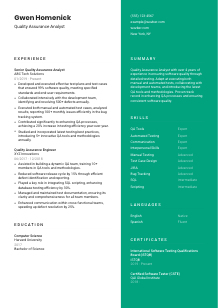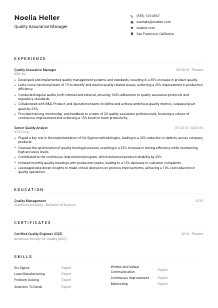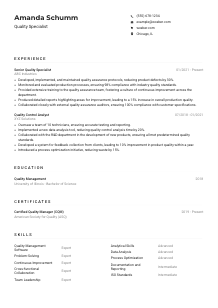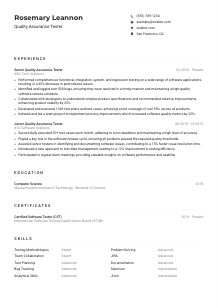Quality Assurance Analyst Resume Example
Ensuring top-notch quality, but your resume feels glitchy? Dive into this Quality Assurance Analyst resume example, streamlined with Wozber free resume builder. Discover how to detail your testing skills to align with job requirements, making your career as flawless as the products you ensure!
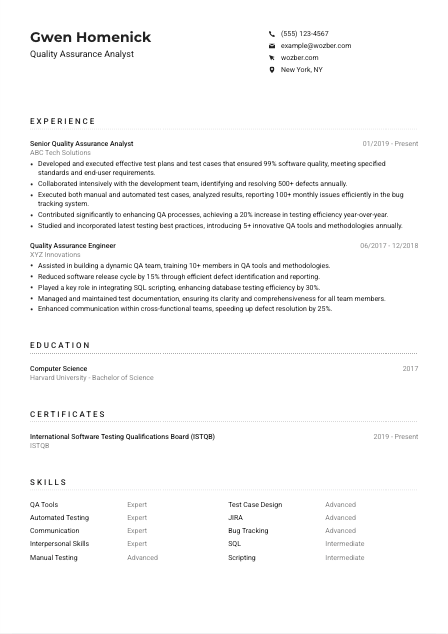
How to write a Quality Assurance Analyst resume?
Welcome, aspiring Quality Assurance Analyst! The quest for crafting that pitch-perfect resume is akin to performing a meticulous QA test on a new software: both require an eye for detail, precision, and a deep understanding of the end goal. With the tech world's competitive landscape, your resume is not just a document, but a golden ticket to your dream role.
Armed with Wozber, a free resume builder that breathes life into ATS-compliant resumes, you're about to unlock the secrets of aligning your qualifications with your desired position seamlessly. Let's turn the spotlight on you, transforming your resume into a beacon for hiring managers.
Personal Details
The "Personal Details" section might seem like mere formalities, yet here lies your first impression. Marrying the specifics of the Quality Assurance Analyst role with your introduction is like scripting the perfect test case—it prepares you for success. Let's ensure your personal details resonate with technical prowess and professional clarity.
1. Brand Yourself with Your Name
Consider your name the "variable" that stands out in every test case. Ensure it's the highlight with a clear and bold font. Think of it as the main function name in your script: it needs to be seen and remembered.
2. Declare Your Role
Position yourself straight away by listing 'Quality Assurance Analyst' right below your name. This aligns you with the job at first glance, acting like a well-placed comment in a script that guides the reader through the purpose of the code.
3. Optimize Contact Details
Your phone and professional email are your callbacks—ensure they are correct and lead straight to you. A professional email format (firstname.lastname@email.com) avoids any ‘debugging' later when the recruiter tries to contact you.
4. Confirm Your Location
With the job rooted in New York, NY, highlight this as your location. It's like passing a critical parameter in your testing function—ensuring you fit the geo-specific requirements of the job.
5. Link to Your Digital Portfolio
If you have a LinkedIn profile or a personal website showcasing your projects or certifications, include it. Think of it as linking to your repository hosting your portfolio of 'successful test cases' and certifications.
Takeaway
Your personal details are the initial handshake, offering a snapshot of your professional essence. Precision here sets the tone, proving you're a perfect fit even before they dive into the core of your resume.





Experience
In the realm of Quality Assurance, your experience is your test log—detailing the errors caught, rectified, and the improvements made. It's your practical proof of expertise. Leverage this section to echo the job's demands, demonstrating your invaluable contribution to software quality.
- Developed and executed effective test plans and test cases that ensured 99% software quality, meeting specified standards and end‑user requirements.
- Collaborated intensively with the development team, identifying and resolving 500+ defects annually.
- Executed both manual and automated test cases, analyzed results, reporting 100+ monthly issues efficiently in the bug tracking system.
- Contributed significantly to enhancing QA processes, achieving a 20% increase in testing efficiency year‑over‑year.
- Studied and incorporated latest testing best practices, introducing 5+ innovative QA tools and methodologies annually.
- Assisted in building a dynamic QA team, training 10+ members in QA tools and methodologies.
- Reduced software release cycle by 15% through efficient defect identification and reporting.
- Played a key role in integrating SQL scripting, enhancing database testing efficiency by 30%.
- Managed and maintained test documentation, ensuring its clarity and comprehensiveness for all team members.
- Enhanced communication within cross‑functional teams, speeding up defect resolution by 25%.
1. Dissect the Job Description
Begin by meticulously examining the job description, much like you would analyze a software spec. Highlight phrases like 'develop and implement test plans', 'manual and automated testing', and 'collaborate closely with development teams'. These keywords are your test parameters.
2. Structure Your Validation Sequence
Organize your roles chronologically, starting with the most recent. For each role, think of it as defining a new test scenario—include your title, company, and time frame clearly.
3. Design Precise Test Assertions
Detail accomplishments that directly correspond to the highlighted job demands. Use verbs like 'developed', 'collaborated', and 'executed', followed by quantitative outcomes, e.g., 'ensured 99% software quality', 'resolved 500+ defects annually'. This section is your opportunity to show the impact of your tests.
4. Present Test Metrics
Quantifying achievements not only adds credibility but also makes your contributions graspable. Like presenting the pass/fail rate in a test report, showing metrics such as 'enhanced QA processes, achieving a 20% increase in testing efficiency' conveys your effectiveness vividly.
5. Filter Out Irrelevant Tests
While it might be tempting to list all experiences, focus solely on those relevant to a Quality Assurance Analyst role. This streamlines your resume, making it a targeted test suite rather than a broad regression test.
Takeaway
Your experience section is a testament to your problem-solving and improvement skills in the realm of quality assurance. Well-crafted and precise, it narrates your professional journey, placing you as the ideal candidate who not only finds defects but enhances overall quality.
Education
While the tech world often prioritizes experience, your educational background lays down the theoretical framework for your practical skills. It's your script's documentation—vital for understanding the bigger picture. Let's fine-tune your education to reflect its importance in your QA Analyst role.
1. Identify Educational Prerequisites
Your Bachelor's degree in Computer Science maps directly to the job's requirements. Highlight this, akin to flagging a key method in your code that affects overall functionality. This directly shows compatibility with the job's foundational needs.
2. Format with Clarity
Structure this section for quick readability: Degree, Field, Institution, and Graduation Year. This clarity ensures the recruiter can easily parse your qualifications, similar to well-formatted code that's easy to understand.
3. Specify Relevant Details
If your degree title closely matches the job requirement, as in our example of a "Bachelor of Science in Computer Science", make it prominent. It assures the recruiter of your relevant theoretical foundation.
4. Highlight Pertinent Courses
For roles demanding specific knowledge, listing relevant courses can underline your preparedness. Here, mentioning courses in software testing, programming, or databases could offer additional assurance of your qualification depth.
5. Include Supplementary Educational Achievements
If you've acquired honors, participated in tech clubs, or completed impactful projects, mention these. While more senior roles may gloss over these details, they can be crucial in illustrating your early dedication and potential.
Takeaway
Your education section is more than a list; it's the schema defining your knowledge base. Presented effectively, it not only validates your technical qualifications but underscores a lifelong commitment to your field.
Certificates
In the evolving tech landscape, certificates stand as badges of continual learning and specialization. For a Quality Assurance Analyst, these signify a dedication to mastering the craft. Let's sort through which certifications to spotlight and how to present them for maximum impact.
1. Sync with Job Requisites
The job description's mention of preferred certifications like ISTQB or CSTE directs you to which badges should headline this section. These act as your industry-recognized keywords, instantly aligning your resume with the role's specifics.
2. Curate to Resonate
Listing only the certifications closely related to QA rather than an exhaustive list emphasizes your targeted expertise. This selective presentation assures the hiring manager of your relevant prowess.
3. Mark Dates Wisely
If your certifications are recent or have an expiry date, including this information is crucial. It shows your commitment to staying updated in the fast-paced QA field.
4. Pursue Continual Upgrading
The tech sector and its methodologies evolve rapidly. Keeping your certifications current, and continuously adding to your qualifications demonstrate your proactivity and a genuine passion for quality assurance.
Takeaway
Precisely curated and up-to-date certifications underscore your specialization and readiness for the role. They act as proof of your commitment to maintaining the highest QA standards, setting you apart in a crowded candidate pool.
Skills
The 'Skills' section is your professional toolkit at a glance. Here, the relevance and presentation of your skills can make a dramatic difference. For a Quality Assurance Analyst, balancing technical prowess with soft skills is key. Let's fine-tune this section to reflect your well-rounded expertise.
1. Extract from the Job Description
Analyze the job posting for specific skills: 'QA tools', 'manual and automated testing', and 'strong knowledge of SQL and scripting'. These are your primary colors, crucial for painting a picture of a skilled QA Analyst.
2. Prioritize Pertinent Skills
Match and list your skills that directly reflect the job's requirements. Place the most relevant ones like ‘QA Tools' and ‘Automated Testing' at the top to capture attention swiftly.
3. Organize for Impact
Instead of inundating with every skill you possess, focus on those most relevant to the job at hand. This prioritization makes it easy for recruiters to see your fit for the role, much like clean, commented code enables easy understanding and maintenance.
Takeaway
Your skill set is a showcase of your capability. By tailoring and organizing this section, you make a compelling case for your candidacy, reflecting both your proficiency in QA and your well-rounded professional profile.
Languages
In our interconnected world, the ability to communicate across languages can be a unique advantage. Especially in diverse teams or global companies, showcasing your linguistic skills might just give you the edge. Let's navigate how to ornament your resume with your languages, emphasizing their professional value.
1. Verify Job Language Requirements
The job stipulates 'Strong English fluency'. This is a non-negotiable, so ensure English tops your languages list, labeled as ‘Native' or ‘Fluent' to match the job's call.
2. Elevate Unambiguous Languages
List your languages clearly. For instance, if you're bilingual or have proficiency in languages beyond what the job specifies, include them. This can hint at your ability to thrive in diverse work environments.
3. Catalogue Additional Languages
Even if the job description doesn't explicitly demand other languages, your multilingual skills demonstrate adaptability and readiness for global engagement, making you a well-rounded candidate.
4. Be Frank with Your Proficiency Levels
Honesty in depicting your language proficiency avoids miscommunication. Clearly differentiate between 'Fluent', 'Intermediate', and 'Basic'—this precision avoids ambiguities akin to bugs in a codebase.
5. Align with Global Roles
For positions implying international interaction, extra language skills are a bonus. They showcase your capability for clear communication across cultural divides, enhancing your professional reach.
Takeaway
Your linguistic skills are not merely personal attributes; they are professional tools that broaden your appeal to employers in our global industry. Flaunt them proudly, and let them illustrate your adaptability and global potential.
Summary
The 'Summary' section is your moment to shine, a brief but potent narrative that encapsulates your professional identity. For a Quality Assurance Analyst, it's about highlighting your skills, experience, and defining qualities that make you stand out. Let's construct a summary that compels hiring managers to proceed with eager interest.
1. Decode the Role
Digest the job requirements thoroughly—understand what makes a candidate ideal. This insight will guide you in drafting a summary that resonates with the job's essence.
2. Initiate with your Identity
Start with a clear statement of your professional standing; "Quality Assurance Analyst with over 4 years of experience." This sets the stage, declaring your candidate genre immediately.
3. Validate with Achievements
Follow your introduction with a concise showcase of how you've excelled in key areas relevant to the role. Like passing tests, each achievement you list is a proof point of your capability.
4. Summarize with Precision
Maintain brevity, aiming for no more than 3-5 compelling lines. Your summary isn't the full test report; think of it as the executive summary that draws stakeholders' interest.
Takeaway
Your summary is the headline of your professional story, enticing the reader to dive deeper into the document. Make it impactful, resonating with the Quality Assurance Analyst role, and you'll have taken a significant step toward your next career milestone.
Launching Your Quality Assurance Analyst Journey
Congratulations on completing this detailed crafting of your Quality Assurance Analyst resume! By adopting these targeted strategies, you're not just applying for a job; you're showcasing a meticulously coded script of your professional life, designed to pass the rigorous tests of the hiring process. With Wozber's free resume builder, ATS-friendly resume template, and ATS resume scanner, you have the tools at your disposal to ensure your resume is not only seen but also remembered. Dive in, tailor your resume with precision, and let your career in quality assurance ascend to new heights.

- Bachelor's degree in Computer Science, Information Systems, or related field.
- Minimum of 3 years experience in quality assurance, including manual and automated testing.
- Proficiency with QA tools and methodologies, as well as experience in writing clear, concise, and comprehensive test plans and test cases.
- Strong knowledge of SQL and scripting for database testing purposes.
- Effective interpersonal and communication skills, both written and verbal, to collaborate with cross-functional teams.
- Certification in Quality Assurance such as ISTQB or CSTE preferred.
- Strong English fluency is essential for this role.
- Must be located in New York, NY.
- Develop and implement effective test plans and test cases to ensure the software quality meets specified standards and end-user requirements.
- Collaborate closely with development teams to identify, report, and resolve defects in a timely manner.
- Execute manual and automated test cases, analyze results, and report and track issues in a bug tracking system.
- Contribute to the continuous improvement of QA processes, practices, and systems.
- Stay updated with the latest testing best practices, QA tools, and methodologies.






